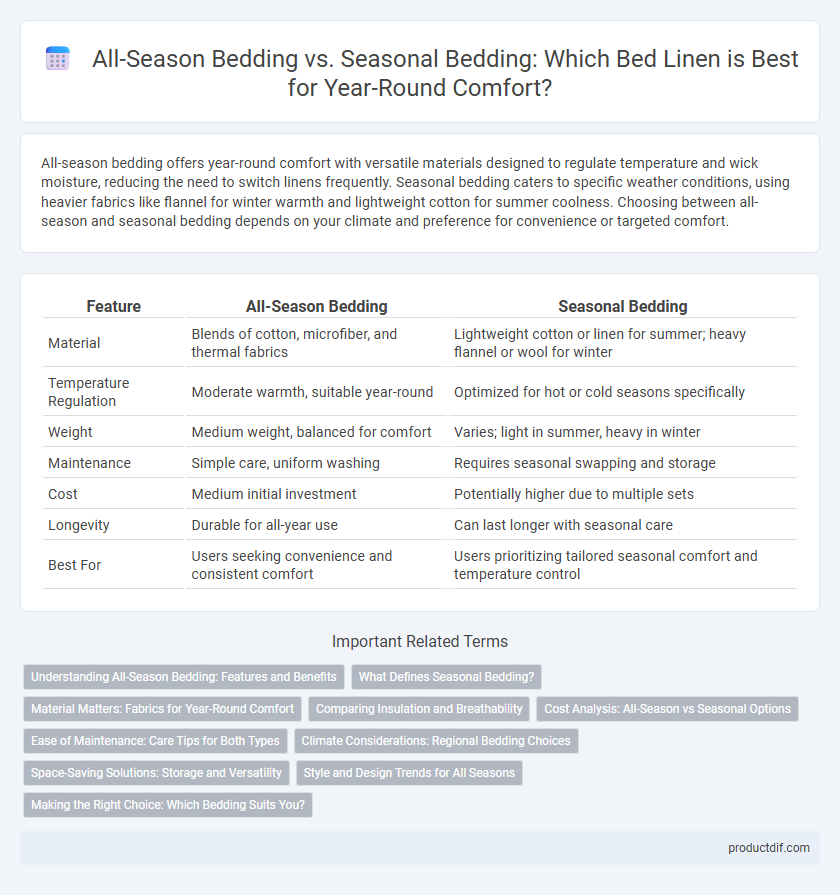All-season bedding offers year-round comfort with versatile materials designed to regulate temperature and wick moisture, reducing the need to switch linens frequently. Seasonal bedding caters to specific weather conditions, using heavier fabrics like flannel for winter warmth and lightweight cotton for summer coolness. Choosing between all-season and seasonal bedding depends on your climate and preference for convenience or targeted comfort.
Table of Comparison
| Feature | All-Season Bedding | Seasonal Bedding |
|---|---|---|
| Material | Blends of cotton, microfiber, and thermal fabrics | Lightweight cotton or linen for summer; heavy flannel or wool for winter |
| Temperature Regulation | Moderate warmth, suitable year-round | Optimized for hot or cold seasons specifically |
| Weight | Medium weight, balanced for comfort | Varies; light in summer, heavy in winter |
| Maintenance | Simple care, uniform washing | Requires seasonal swapping and storage |
| Cost | Medium initial investment | Potentially higher due to multiple sets |
| Longevity | Durable for all-year use | Can last longer with seasonal care |
| Best For | Users seeking convenience and consistent comfort | Users prioritizing tailored seasonal comfort and temperature control |
Understanding All-Season Bedding: Features and Benefits
All-season bedding offers versatile temperature regulation by combining breathable fabrics and insulating materials, providing comfort throughout the year without the need to switch sets. Designed with moisture-wicking properties and thermal balance, this type of bedding adapts to both warm summers and cold winters, enhancing sleep quality. Investing in all-season bedding reduces the hassle and storage space required for multiple seasonal sets, making it a practical and cost-effective choice.
What Defines Seasonal Bedding?
Seasonal bedding is designed to match the temperature and humidity fluctuations throughout the year, utilizing materials that provide insulation in winter and breathability in summer. Fabrics such as flannel and fleece are common for cold seasons, while cotton and linen are preferred for warmer months due to their moisture-wicking properties. The key characteristic of seasonal bedding is its adaptability to climatic changes, ensuring optimal comfort by regulating body temperature accordingly.
Material Matters: Fabrics for Year-Round Comfort
All-season bedding often features breathable cotton or moisture-wicking bamboo fabrics that regulate temperature to ensure comfort across diverse climates. Seasonal bedding typically incorporates heavier materials like flannel or lightweight linens tailored to specific weather conditions, optimizing warmth or coolness. Selecting natural, hypoallergenic fabrics enhances durability and skin health, making material choice crucial for year-round bedding performance.
Comparing Insulation and Breathability
All-season bedding offers a balanced combination of insulation and breathability, designed to maintain comfort across varying temperatures by using materials like cotton blends or lightweight microfiber. Seasonal bedding, in contrast, prioritizes insulation or breathability to match specific weather conditions, with heavier flannel or fleece for winter warmth and breathable linen or percale for summer cooling. Choosing between the two depends on climate variability and personal temperature preferences, affecting sleep quality and energy efficiency.
Cost Analysis: All-Season vs Seasonal Options
All-season bedding offers a cost-effective solution by eliminating the need to purchase multiple sets for different times of the year, reducing overall expenses and storage needs. Seasonal bedding requires frequent replacements to match seasonal temperature changes, leading to higher cumulative costs over time. Investing in versatile materials like breathable cotton or moisture-wicking blends in all-season options maximizes durability and value, minimizing long-term expenditures.
Ease of Maintenance: Care Tips for Both Types
All-season bedding designed with breathable, durable fabrics like cotton blends simplifies washing and drying, reducing wrinkle formation and minimizing the need for special cleaning methods. Seasonal bedding, often featuring heavier materials like flannel or silk, requires tailored care such as cold water washing for delicates or low heat drying to maintain texture and longevity. Proper maintenance extends the life of both types, ensuring softness and hygiene without frequent replacements.
Climate Considerations: Regional Bedding Choices
Regional bedding choices hinge on climate considerations, with all-season bedding offering versatile temperature regulation suitable for moderate zones. Seasonal bedding, such as flannel for winter and lightweight cotton for summer, caters to extreme weather variations in specific regions. Selecting appropriate bed linen enhances sleep comfort by aligning fabric breathability and warmth with local climate conditions.
Space-Saving Solutions: Storage and Versatility
All-season bedding offers space-saving benefits by combining versatile materials that regulate temperature year-round, eliminating the need for multiple sets. Seasonal bedding requires extra storage space for bulky winter quilts and lighter summer sheets, increasing clutter in limited bedrooms. Choosing all-season options maximizes closet efficiency and simplifies bed linen management, ideal for small living spaces.
Style and Design Trends for All Seasons
All-season bedding offers versatile style and design trends that seamlessly complement various interior decors throughout the year, with neutral palettes, minimalist patterns, and breathable fabrics like cotton and linen dominating the market. Seasonal bedding, however, leans heavily into bold colors, thematic prints, and textures aligned with specific times of the year, such as warm flannels for winter and light, floral motifs for spring. Consumers increasingly prefer all-season designs for their timeless appeal and ability to create a cohesive bedroom aesthetic without frequent changes.
Making the Right Choice: Which Bedding Suits You?
All-season bedding offers versatile comfort by regulating temperature throughout the year, utilizing breathable fabrics like cotton or microfiber that adapt to varying climates. Seasonal bedding typically includes heavier materials such as flannel or fleece for winter warmth and lightweight linens or percale cotton for summer coolness. Choosing the right bedding depends on your local climate, personal temperature preferences, and maintenance priorities, ensuring optimal sleep quality regardless of the season.
All-Season Bedding vs Seasonal Bedding Infographic

 productdif.com
productdif.com